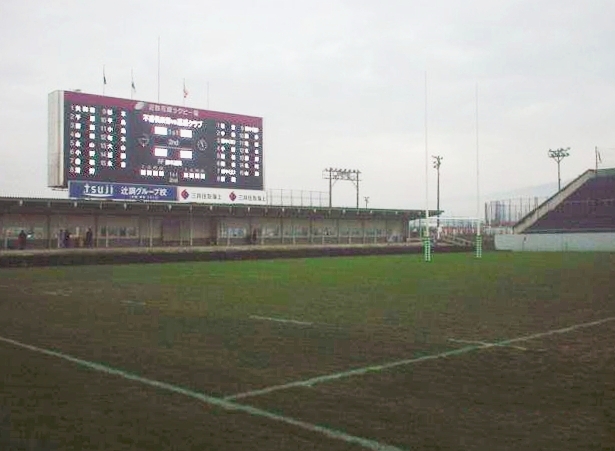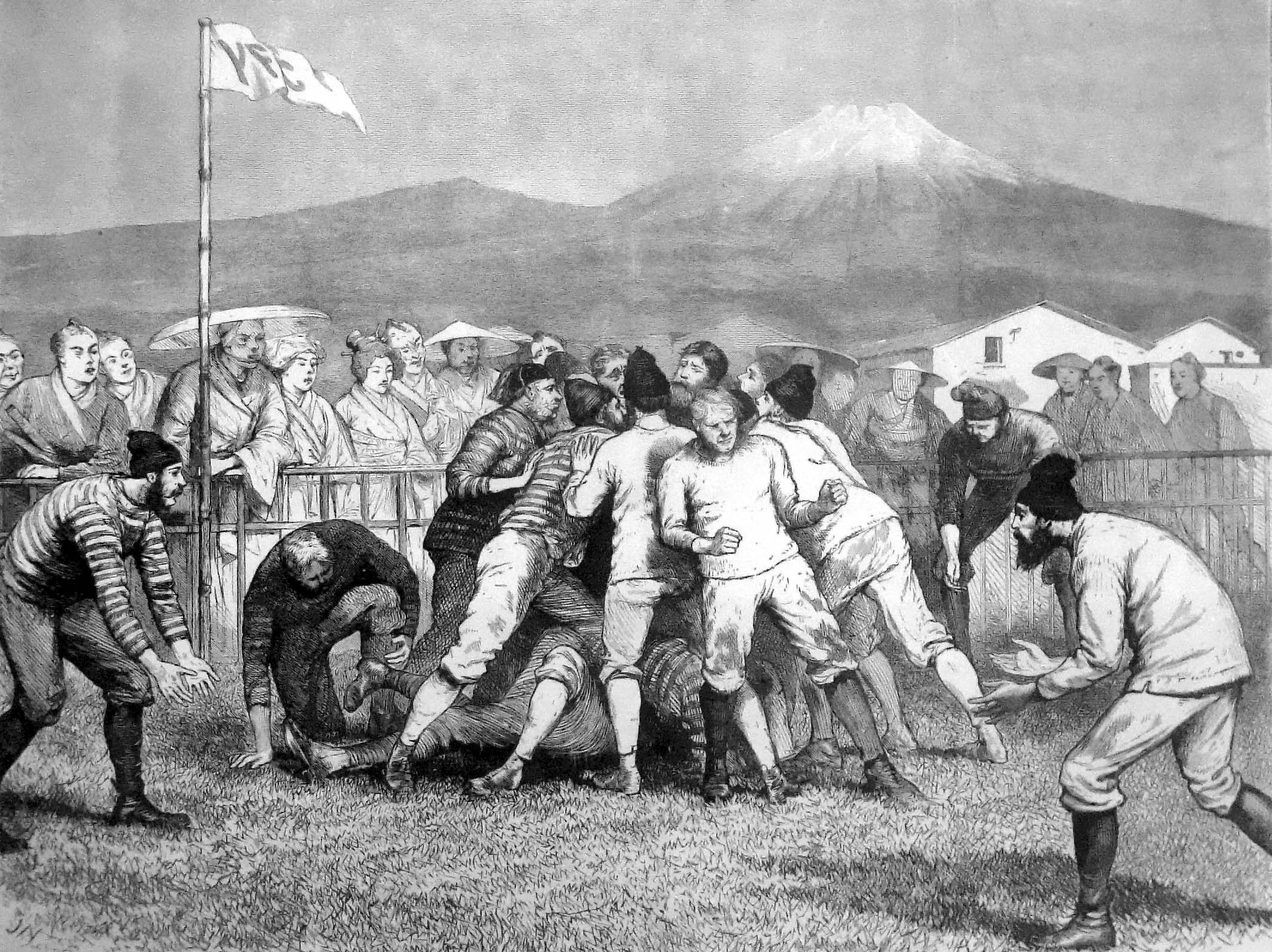|
Kintetsu Hanazono Rugby Stadium
The in Higashiosaka is the oldest rugby union stadium in Japan specifically dedicated to rugby. Its location is next to Hanazono Central Park (ĶŖ▒Õ£ÆõĖŁÕż«Õģ¼Õ£Æ, ''Hanazono Ch┼½┼Ź K┼Źen''). Owned by the City of Higashiosaka, it opened in 1929 with a capacity of 27,346. It is the stage for the annual National High School Rugby Tournament held every year at the end of December and has hosted important international, Top League games. Hanazono is the home of the Kintetsu Liners rugby union team and J. League club, FC Osaka. The stadium was selected as one of the venues for 2019 Rugby World Cup (Japan) which was the first Rugby World Cup to be held in Asia. World record On May 14, 2006 Daisuke Ohata broke the record for the most overall tries in test matches at Hanazono with a hat-trick for Japan against Georgia. The previous record holder was David Campese. Football It hosted the J1 League game between Cerezo Osaka and Nagoya Grampus Eight played there on May 8, 1999. FC Osak ... [...More Info...] [...Related Items...] OR: [Wikipedia] [Google] [Baidu] |
J3 League
or simply J3 is the third division of . It was established in 2013 as the third-tier professional association football league in Japan under the organization of J.League. The league is known as the for sponsorship reasons. The third-tier nationwide league is a relatively recent development in Japanese football with a first attempt made in 1992 Japan Football League, 1992 (second division of the Japan Football League (1992ŌĆō98), old JFL), though it only lasted for two seasons. In 1999, following the establishment of J2 League, a new Japan Football League was created to comprise the third tier and lower divisions. After the introduction of J3, the JFL was demoted to the fourth-tier nationwide league, for the first time in history of Japanese football. History of Japanese third-tier football Amateur era (until 2013) A national third tier of Japanese association football was first established along with its professionalization in 1992, when the newly created Japan Football League ... [...More Info...] [...Related Items...] OR: [Wikipedia] [Google] [Baidu] |
Japan National Rugby Union Team
The Japan national rugby union team, also known as the Cherry Blossoms, the Brave Blossoms (), or simply Sakura, represents Japan in men's international rugby union. Japan is traditionally the strongest rugby union power in Asia and has enjoyed and endured mixed results against non-Asian teams over the years. Rugby union in Japan is administered by the Japan Rugby Football Union (JRFU), which was founded in 1926. They compete annually in the Pacific Nations Cup (PNC) and previously in the Asia Rugby Championship (ARC). They have also participated in every Rugby World Cup (RWC) since the tournament began in 1987, and hosted the event in 2019 Rugby World Cup, 2019. Rugby was first played in Japan's treaty ports as early as 1866. Popular participation by local university teams was established in 1899 and Japan's first recorded international match was a match against a Canadian team in 1932. Notable games for Japan include a victory over the Junior All Blacks in 1968, and a narrow 6 ... [...More Info...] [...Related Items...] OR: [Wikipedia] [Google] [Baidu] |
Nara Line (Kintetsu)
The is a Japanese railway line owned by the Kintetsu Railway. The line connects Fuse Station in the eastern suburbs of Osaka to Kintetsu Nara Station in the historic city of Nara, though operationally, the line begins at ┼īsaka Namba Station on the Namba Line. Additionally, some trains run through-services starting at Kobe Sannomiya Station on the Hanshin Railway Main Line in Kobe. Eastern satellite cities such as Higashiosaka and Ikoma are connected by the line. This line is more direct than the JR line between Osaka and Nara. History The line was opened by in 1914, dual track and electrified at 600 VDC. Whereas the JR West Yamatoji Line routes south of the Ikoma mountain range to connect Osaka and Nara, the Kintetsu Nara Line uses a tunnel through the Ikoma mountain range. As a result, the Kintetsu route is more direct and has allowed municipalities along the line such as Ikoma to flourish as major commuter hubs. To respond to high demand, the railway operates se ... [...More Info...] [...Related Items...] OR: [Wikipedia] [Google] [Baidu] |
Kintetsu Railway
, referred to as and officially Kinki-Nippon Railway, is a Japanese passenger railway company, managing infrastructure and operating passenger train service. Its railway system is the largest in Japan, excluding Japan Railways Group. The railway network connects Osaka, Nara, Nara, Nara, Kyoto, Nagoya, Tsu, Mie, Tsu, Ise, Mie, Ise, and Yoshino, Nara, Yoshino. Kintetsu Railway Co., Ltd. is a wholly owned subsidiary of Kintetsu Group Holdings Co., Ltd. History On September 16, 1910, was founded and renamed a month after. Osaka Electric Tramway completed Ikoma Tunnel and started operating a line between Osaka and Nara (present-day Nara Line (Kintetsu), Nara Line) on April 30, 1914. The modern Kashihara, Osaka, and Shigi lines were completed in the 1920s, followed by the Kyoto Line (a cooperative venture with Keihan Electric Railway). Daiki founded in 1927, which consolidated on September 15, 1936. In 1938, Daiki teamed up with its subsidiary to operate the first private rail ... [...More Info...] [...Related Items...] OR: [Wikipedia] [Google] [Baidu] |
Higashi-Hanazono Station
is a passenger railway station in located in the city of Higashi┼Źsaka, Osaka Prefecture, Japan, operated by the private railway operator Kintetsu Railway. It is the nearest station to Higashi Osaka Hanazono Rugby Stadium. Lines Higashi-Hanazono Station is served by the Nara Line, and is located 5.8 rail kilometers from the starting point of the line at Fuse Station and 11.9 kilometers from ┼īsaka Namba Station. Station layout The station consists of two elevated 10-car length island platforms serving four tracks, with the station building underneath. Higashi-Hanazono Inspection Depot is connected from the siding tracks numbered 1 and 3. Platforms File:Higashi-Hanazono Station south entrance1.jpg, The south building during elevation work File:Higashi-Hanazono Station platform1.jpg, The platforms during elevation work Adjacent stations When major events are held at Higashi Osaka Hanazono Rugby Stadium, some express trains and some rapid express trains stop ... [...More Info...] [...Related Items...] OR: [Wikipedia] [Google] [Baidu] |
2007ŌĆō08 Top League ...
The 2007ŌĆō08 Top League was the fifth season of Japan's domestic rugby union competition, the Top League. The Sanyo Wild Knights became the first ever team in the Top League to win all their league games, but were defeated for the Top League title by Suntory Sungoliath 14-10 in the Microsoft Cup final on February 24, 2008 at Chichibunomiya. The Top League is a semi-professional competition which is at the top of the national league system in Japan, with promotion and relegation between the next level down. {{DEFAULTSORT:2007-08 Top League Japan Rugby League One 1 Jap ''Jap'' is an English abbreviation of the word " Japanese". In the United States, some Japanese Americans have come to find the term offensive because of the internment they suffered during World War II. Before the attack on Pearl Harbor, ''Jap ... [...More Info...] [...Related Items...] OR: [Wikipedia] [Google] [Baidu] |
National Stadium (Tokyo, 1958)
was a multi-purpose stadium in Kasumigaoka, Shinjuku, Tokyo, Japan. The stadium served as the main stadium for the opening and closing ceremonies, as well as being the venue for track and field events at the 1964 Summer Olympics. The Japan national football team's home matches and major football club cup finals were held at the stadium. The stadium's official capacity was 57,363, but the seating capacity was only 48,000 seats. Demolition was completed in May 2015, and the site was redeveloped with a new larger-capacity Olympic Stadium. The new stadium was the main venue for the 2020 Summer Olympics and Paralympics. The original plans for the new stadium were scrapped in July 2015 by Japanese prime minister Shinzo Abe, who announced a rebid after a public outcry because of increased building costs. As a result, the new design was not ready for the 2019 Rugby World Cup, as originally intended. A new design created by architect Kengo Kuma was chosen in December 2015 to ... [...More Info...] [...Related Items...] OR: [Wikipedia] [Google] [Baidu] |
Level-5 Stadium
(official name: Higashi-Hirao Park Hakatanomori Football Stadium (µØ▒Õ╣│Õ░ŠÕģ¼Õ£ÆÕŹÜÕżÜŃü«µŻ«ńÉāµŖĆÕĀ┤), renamed on March 1, 2008 for naming rights), is located in the Hakata Ward of Fukuoka, Fukuoka Prefecture, Japan. It is the home ground of the J1 League association football club Avispa Fukuoka. History Best Denki Stadium is located in Higashi Hirao Park (commonly known as "Hakata no Mori" (ÕŹÜÕżÜŃü«µŻ«)), Fukuoka City, Fukuoka Prefecture. This park has been built as a sports park in the hills near the city-town border with Shime Town, Kasuya District, which is adjacent to the east side of the runway at Fukuoka Airport. This is Fukuoka City's first football-specific stadium, which was constructed in 1995 to serve as the main soccer venue for the Universiade Fukuoka Tournament held in Fukuoka. The stadium also hosts rugby union matches, including a few international matches, Top League games, Top League Challenge series and Top Kyushu league games. It was also host to fo ... [...More Info...] [...Related Items...] OR: [Wikipedia] [Google] [Baidu] |
Chichibunomiya Rugby Stadium
(also called Prince Chichibu Memorial Stadium) is a rugby union stadium located in the Aoyama district of central Tokyo, Japan. It is the spiritual home of Japanese rugby union and the headquarters of the Japan Rugby Football Union. Named for Prince Chichibu, the late brother of Emperor Hirohito, the venue is used mostly for rugby sevens and rugby union matches. Redevelopment plans call for the stadium and the adjacent Meiji Jingu Stadium, used for baseball, to be demolished and replaced with new facilities. Facilities The stadium currently can accommodate 27,188 spectators, but only part of the stands are covered. A large electronic scoreboard was added to the grounds as a step toward modernization before the fifth Rugby World Cup in 2003. On April 19, 2007, it was announced that the stadium was to be equipped with lights for night games by the end of July, to assist with the RWC 2015 bid. The first rugby game under lights was Japan v Asian Barbarians in August 2007, the sen ... [...More Info...] [...Related Items...] OR: [Wikipedia] [Google] [Baidu] |
Higashi Osaka Hanazono Rugby Stadium Ground
Higashi (Japanese µØ▒ ''east'') may refer to: Places in Japan *Higashi, Shibuya *Higashi, Fukushima *Higashi, Okinawa *Higashi-ku, Fukuoka *Higashi-ku, Hiroshima *Higashi-ku, Nagoya *Higashi-ku, Sapporo People * Keigo Higashi, Japanese footballer * Kelly Higashi, American judge and lawyer * Kotaro Higashi, Japanese footballer *, Japanese boxer *, Japanese footballer * Carlos Burella Higashi, Peruvian footballer Fictional characters * Joe Higashi, in ''Fatal Fury'' * Kotaro Higashi, an alter ego of Ultraman Taro * Setsuna Higashi, in ''Fresh Pretty Cure!'' Other uses * Higashi (food), Japanese confectionery See also *Azuma (other) (the Japanese character for ''east'' is also pronounced ''azuma'') *East (other) East is a cardinal direction or compass point. East or the East may also refer to: Places * Eastern world, or the East or historically the Orient, usually including Asia, the Mediterranean region and the Arab world ** Orient, the East in rela ... ... [...More Info...] [...Related Items...] OR: [Wikipedia] [Google] [Baidu] |



